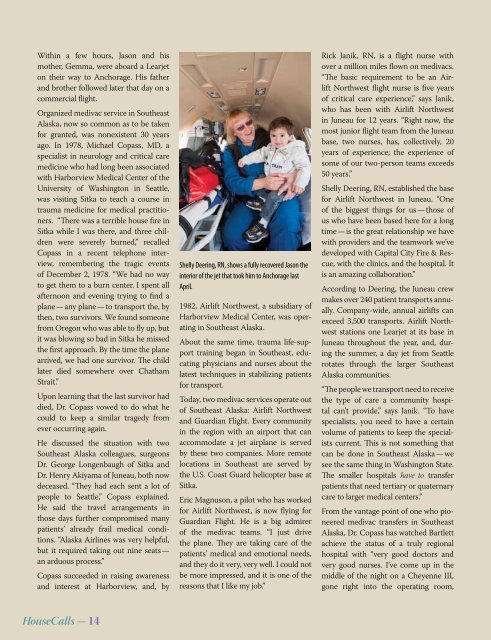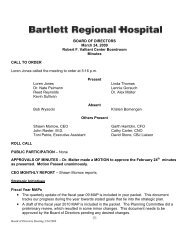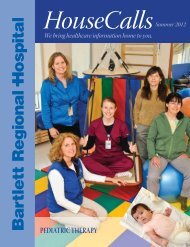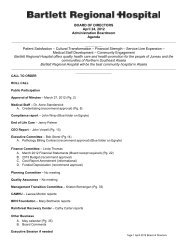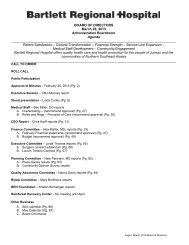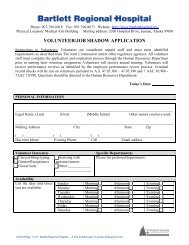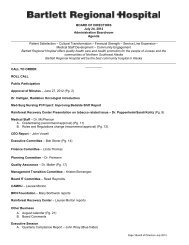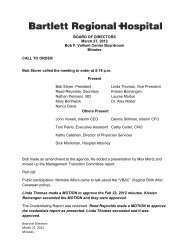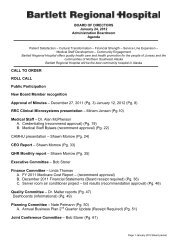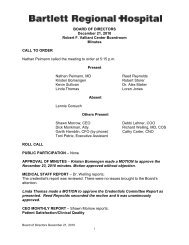Newsletter - Bartlett Regional Hospital
Newsletter - Bartlett Regional Hospital
Newsletter - Bartlett Regional Hospital
Create successful ePaper yourself
Turn your PDF publications into a flip-book with our unique Google optimized e-Paper software.
Within a few hours, Jason and his<br />
mother, Gemma, were aboard a Learjet<br />
on their way to Anchorage. His father<br />
and brother followed later that day on a<br />
commercial flight.<br />
Organized medivac service in Southeast<br />
Alaska, now so common as to be taken<br />
for granted, was nonexistent 30 years<br />
ago. In 1978, Michael Copass, MD, a<br />
specialist in neurology and critical care<br />
medicine who had long been associated<br />
with Harborview Medical Center of the<br />
University of Washington in Seattle,<br />
was visiting Sitka to teach a course in<br />
trauma medicine for medical practitioners.<br />
“There was a terrible house fire in<br />
Sitka while I was there, and three children<br />
were severely burned,” recalled<br />
Copass in a recent telephone interview,<br />
remembering the tragic events<br />
of December 2, 1978. “We had no way<br />
to get them to a burn center. I spent all<br />
afternoon and evening trying to find a<br />
plane—any plane—to transport the, by<br />
then, two survivors. We found someone<br />
from Oregon who was able to fly up, but<br />
it was blowing so bad in Sitka he missed<br />
the first approach. By the time the plane<br />
arrived, we had one survivor. The child<br />
later died somewhere over Chatham<br />
Strait.”<br />
Upon learning that the last survivor had<br />
died, Dr. Copass vowed to do what he<br />
could to keep a similar tragedy from<br />
ever occurring again.<br />
He discussed the situation with two<br />
Southeast Alaska colleagues, surgeons<br />
Dr. George Longenbaugh of Sitka and<br />
Dr. Henry Akiyama of Juneau, both now<br />
deceased. “They had each sent a lot of<br />
people to Seattle,” Copass explained.<br />
He said the travel arrangements in<br />
those days further compromised many<br />
patients’ already frail medical conditions.<br />
“Alaska Airlines was very helpful,<br />
but it required taking out nine seats—<br />
an arduous process.”<br />
Copass succeeded in raising awareness<br />
and interest at Harborview, and, by<br />
Shelly Deering, RN, shows a fully recovered Jason the<br />
interior of the jet that took him to Anchorage last<br />
April.<br />
1982, Airlift Northwest, a subsidiary of<br />
Harborview Medical Center, was operating<br />
in Southeast Alaska.<br />
About the same time, trauma life-support<br />
training began in Southeast, educating<br />
physicians and nurses about the<br />
latest techniques in stabilizing patients<br />
for transport.<br />
Today, two medivac services operate out<br />
of Southeast Alaska: Airlift Northwest<br />
and Guardian Flight. Every community<br />
in the region with an airport that can<br />
accommodate a jet airplane is served<br />
by these two companies. More remote<br />
locations in Southeast are served by<br />
the U.S. Coast Guard helicopter base at<br />
Sitka.<br />
Eric Magnuson, a pilot who has worked<br />
for Airlift Northwest, is now flying for<br />
Guardian Flight. He is a big admirer<br />
of the medivac teams. “I just drive<br />
the plane. They are taking care of the<br />
patients’ medical and emotional needs,<br />
and they do it very, very well. I could not<br />
be more impressed, and it is one of the<br />
reasons that I like my job.”<br />
Rick Janik, RN, is a flight nurse with<br />
over a million miles flown on medivacs.<br />
“The basic requirement to be an Airlift<br />
Northwest flight nurse is five years<br />
of critical care experience,” says Janik,<br />
who has been with Airlift Northwest<br />
in Juneau for 12 years. “Right now, the<br />
most junior flight team from the Juneau<br />
base, two nurses, has, collectively, 20<br />
years of experience; the experience of<br />
some of our two-person teams exceeds<br />
50 years.”<br />
Shelly Deering, RN, established the base<br />
for Airlift Northwest in Juneau. “One<br />
of the biggest things for us— those of<br />
us who have been based here for a long<br />
time—is the great relationship we have<br />
with providers and the teamwork we’ve<br />
developed with Capital City Fire & Rescue,<br />
with the clinics, and the hospital. It<br />
is an amazing collaboration.”<br />
According to Deering, the Juneau crew<br />
makes over 240 patient transports annually.<br />
Company-wide, annual airlifts can<br />
exceed 3,500 transports. Airlift Northwest<br />
stations one Learjet at its base in<br />
Juneau throughout the year, and, during<br />
the summer, a day jet from Seattle<br />
rotates through the larger Southeast<br />
Alaska communities.<br />
“The people we transport need to receive<br />
the type of care a community hospital<br />
can’t provide,” says Janik. “To have<br />
specialists, you need to have a certain<br />
volume of patients to keep the specialists<br />
current. This is not something that<br />
can be done in Southeast Alaska—we<br />
see the same thing in Washington State.<br />
The smaller hospitals have to transfer<br />
patients that need tertiary or quaternary<br />
care to larger medical centers.”<br />
From the vantage point of one who pioneered<br />
medivac transfers in Southeast<br />
Alaska, Dr. Copass has watched <strong>Bartlett</strong><br />
achieve the status of a truly regional<br />
hospital with “very good doctors and<br />
very good nurses. I’ve come up in the<br />
middle of the night on a Cheyenne III,<br />
gone right into the operating room,<br />
HouseCalls — 14


